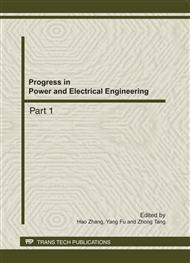p.1321
p.1329
p.1333
p.1338
p.1342
p.1347
p.1353
p.1359
p.1363
Research on High-Power Power Factor Corrector of Power Electronic Transformer
Abstract:
Power electronic transformer (PET) which has a big potential application value in smart grid is an electrical power transformer device adopting power electronic converter and high frequency switch transformer. A new PET with power factor correctors (PFC) is proposed in this paper. Due to high power level of PET, PFC should have a high power level as well. Therefore, the multi-phase interleaved PFC is employed. The paper describes the one cycle control principle, proposes a current synthesis method based on IGBT current, and then analyses the relationship between ripple current and duty cycle of IGBT. In addition, the whole PFC system is simulated completely by means of Matlab/Simulink. In order to verify the theoretical analysis and simulation analysis, a four-phase interleaved PFC with a rated output power of 8.0kW is designed and implemented based on the an analog control chip. The obtained results show that the interleaved PFC by means of one cycle control and current synthesis is feasible, capable of reaching a good suppression effect of ripple current.
Info:
Periodical:
Pages:
1342-1346
Citation:
Online since:
October 2011
Authors:
Keywords:
Price:
Сopyright:
© 2012 Trans Tech Publications Ltd. All Rights Reserved
Share:
Citation:


